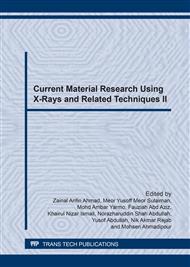p.108
p.112
p.117
p.121
p.126
p.131
p.136
p.141
p.146
The Role of Nb2Zr6O17 Phase on the Hardness and Fracture Toughness of ZTA/Nb2O5 by Cold Isostatic Pressing
Abstract:
The microstructure and mechanical properties of zirconia toughened alumina (ZTA) ceramic added with niobia (Nb2O5) through cold isostatic pressing (CIP) method was investigated. The amount of Nb2O5 is varied from 0 wt.% to 7 wt.%. The phase composition of the sintered bodies was analyzed with an x-ray diffractometer, while their microstructure was observed with a scanning electron microscope. It is found that up to 3 wt.% of Nb2O5 addition, the secondary phase of Nb2Zr6O17 presence as square shape particles confirm by SEM and EDX. The addition of 3 wt.% showed the highest Vickers hardness value with 1600HV. It was observed that, further addition of Nb2O5 (> 3 wt.% ) deteriorates the Vickers hardness of ZTA. While the fracture toughness value increased at 3 wt.% until 5 wt.% of Nb2O5 addition (6.71 MPa · √m and 6.80 MPa · √m respectively). It was also found that the value for bulk density increased and porosity decreased with the increasing of Nb2O5 addition.
Info:
Periodical:
Pages:
126-130
Citation:
Online since:
March 2017
Keywords:
Price:
Сopyright:
© 2017 Trans Tech Publications Ltd. All Rights Reserved
Share:
Citation:


